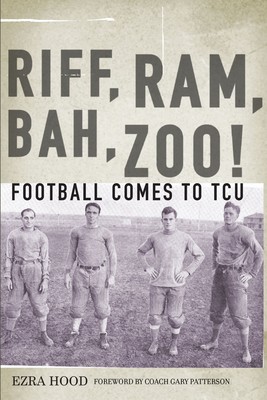
- We will send in 10–14 business days.
- Author: Ezra Hood
- Publisher: Texas Christian University Press
- ISBN-10: 0875655661
- ISBN-13: 9780875655666
- Format: 15 x 22.6 x 1 cm, minkšti viršeliai
- Language: English
- SAVE -10% with code: EXTRA
Reviews
Description
Riff, Ram, Bah, Zoo,
Lickety Lickety, Zoo Zoo,
Who Wah, Wah Who,
Give 'em hell,
TCU!
Ezra Hood's Riff, Ram, Bah, Zoo! Football Comes to TCU (named after TCU's "Riff, Ram" cheer, one of the oldest known cheers in the nation) traces the origins of Texas Christian University, a tiny liberal arts college in Waco, Texas, to its induction into the Southwest Conference in 1922 as an up-and-coming collegiate football power. Drawing from numerous newspaper sources-most notably from the TCU Daily Skiff-Hood's book provides an in-depth, game-by-game history of a football program that struggled to find its place amongst established Texas football programs in the early twentieth century.
Hood begins with the university's conception in 1873, when it was known as AddRan Male and Female College, and describes the rise of football's popularity in Texas. From there, the book chronicles each of TCU's football seasons from its first year in 1896 to its final year in TIAA play, before it joined the Southwest Conference and went on to become, in Hood's words, "the prince of the Southwest in the 1930s."
Hood captures particular details of each season-noting significant coaching changes and highly-touted recruits-all the while providing anecdotes from local newspapers as a way to capture the community response to TCU football in both Waco and Fort Worth. And while the book focuses largely on the ups and downs of the program, Hood also captures the impact of the times on both TCU and the many towns of central and north Texas-the impact of the first World War, for instance, on the state of football nationwide and the loss of notable TCU players to the war effort.
Thanks to Hood's exhaustive historical account, this book will be a valuable reference for both fans and historians of TCU and the game of football.
EXTRA 10 % discount with code: EXTRA
The promotion ends in 21d.16:34:51
The discount code is valid when purchasing from 10 €. Discounts do not stack.
- Author: Ezra Hood
- Publisher: Texas Christian University Press
- ISBN-10: 0875655661
- ISBN-13: 9780875655666
- Format: 15 x 22.6 x 1 cm, minkšti viršeliai
- Language: English English
Riff, Ram, Bah, Zoo,
Lickety Lickety, Zoo Zoo,
Who Wah, Wah Who,
Give 'em hell,
TCU!
Ezra Hood's Riff, Ram, Bah, Zoo! Football Comes to TCU (named after TCU's "Riff, Ram" cheer, one of the oldest known cheers in the nation) traces the origins of Texas Christian University, a tiny liberal arts college in Waco, Texas, to its induction into the Southwest Conference in 1922 as an up-and-coming collegiate football power. Drawing from numerous newspaper sources-most notably from the TCU Daily Skiff-Hood's book provides an in-depth, game-by-game history of a football program that struggled to find its place amongst established Texas football programs in the early twentieth century.
Hood begins with the university's conception in 1873, when it was known as AddRan Male and Female College, and describes the rise of football's popularity in Texas. From there, the book chronicles each of TCU's football seasons from its first year in 1896 to its final year in TIAA play, before it joined the Southwest Conference and went on to become, in Hood's words, "the prince of the Southwest in the 1930s."
Hood captures particular details of each season-noting significant coaching changes and highly-touted recruits-all the while providing anecdotes from local newspapers as a way to capture the community response to TCU football in both Waco and Fort Worth. And while the book focuses largely on the ups and downs of the program, Hood also captures the impact of the times on both TCU and the many towns of central and north Texas-the impact of the first World War, for instance, on the state of football nationwide and the loss of notable TCU players to the war effort.
Thanks to Hood's exhaustive historical account, this book will be a valuable reference for both fans and historians of TCU and the game of football.


Reviews